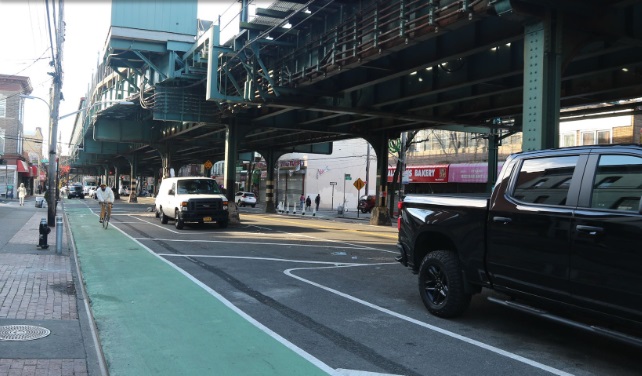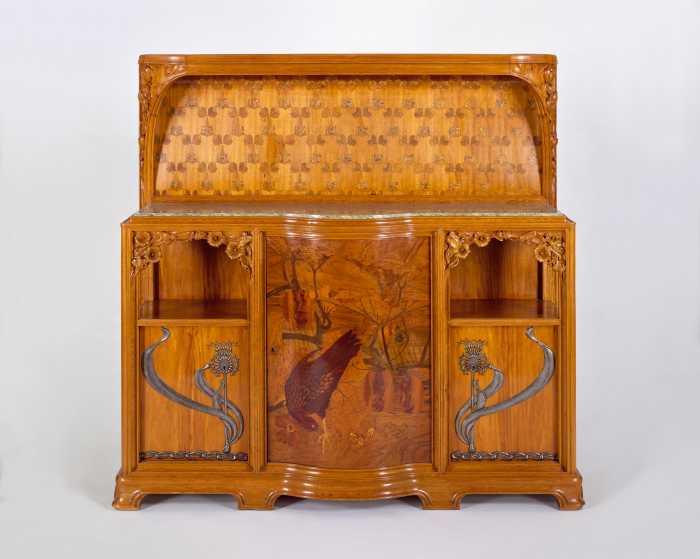
DOT proposal image for 31st Street, showcasing protected bicycle lanes and floating parking spaces. Photo via Change.org
May 1, 2025 By Richard Khuzami
This summer, the NYC Department of Transportation (DOT) will begin installing a protected bike lane under the elevated N train on 31st Street in Astoria, stretching from 36th Avenue to Newtown Avenue. The redesign includes new curbside bike lanes with buffer zones, improved pedestrian crossings and—importantly—no loss of travel lanes for vehicles.
The DOT’s goal is to improve safety on a busy corridor that ranks among the top 10% of Queens streets for serious traffic injuries. That’s a goal we share at the Old Astoria Neighborhood Association (OANA). But to truly make this project successful, a few critical components need more attention.
We support the bike lane in principle. But safety on our streets depends not just on infrastructure, but on how that infrastructure is used—and by whom. Our streets should be safe for everyone in the community, from grandmothers crossing 31st Street to pick up groceries to children walking to school in the morning. We believe four elements are essential to making this redesign work for everyone: traffic controls for bikes and micromobility, enforcement of vehicle type restrictions in bike lanes, reliable support for delivery access through loading zones and micro-hubs and ensuring Saint Demetrios Preparatory School students can safely board their buses without losing the critical street parking their staff relies on.
When we talk about traffic controls, we mean coordinated signage and timed traffic lights that give each group of street users—drivers, cyclists and pedestrians—secure and predictable access to intersections. On 31st Street, this is especially important because the elevated train structure blocks sightlines. You often can’t see what’s coming until it’s too late. Predictable, timed signals and clear signage could dramatically improve safety—not just for cyclists, but for everyone using the road.
One of cyclists’ most legitimate concerns is the sheer size and speed of automobiles. When bikes share intersections with vehicles that are several times larger and heavier, the imbalance is obvious—and intimidating. Thoughtful traffic controls can go a long way toward easing those concerns by creating a sense of order and predictability at conflict points. They don’t restrict movement; they give everyone a fair turn and a clear expectation of what’s coming.
We’ve seen this work in cities like Amsterdam, where bike infrastructure includes timed signals, dedicated signage and even separate signal phases for bikes, cars and pedestrians. These systems reduce conflict, minimize confusion and improve flow.
Enforcement must also be part of the plan from day one. The bike lane is designed for bicycles—but in a neighborhood with a high concentration of delivery services, we’ve seen how quickly those lanes can become dominated by mopeds and scooters. These vehicles move faster, weigh more and pose a different level of risk. When they use bike lanes illegally, they endanger cyclists and pedestrians alike. If mopeds and scooters are allowed to use the bike lanes unchecked, it undermines the safety and utility of the entire project.
Another key to success is ensuring the city supports safe and efficient delivery access along the corridor. We appreciate the plan’s inclusion of loading zones—an important step that has already been implemented successfully on Crescent Street. But to fully meet the needs of businesses and residents, more is required.
We urge the city to incorporate its newly launched microhub program into the 31st Street corridor. These “last-mile” delivery hubs, announced on Earth Day and already operating on the Upper West Side, allow trucks to offload goods into smaller, cleaner vehicles like cargo bikes and handcarts. This reduces the number of large trucks on city streets, cuts down on double parking and aligns perfectly with the goals of the 31st Street redesign. If these hubs can work in Manhattan, they can work in Queens.
31st Street isn’t just a bike route—it’s a vital corridor for residents, businesses, drivers, pedestrians and street vendors. Any redesign must serve all of these users. That’s why our support is contingent on the inclusion and enforcement of these common-sense safety elements—including strong traffic controls, enforcement of vehicle restrictions in bike lanes, full deployment of delivery infrastructure like microhubs and safe accommodations for schoolchildren.
We’re not opposed to bike lanes. Quite the opposite—we want them to succeed. But success depends on designing a system where all users have clear rules, safe space and predictable movement.
This is a rare chance to reshape one of Astoria’s busiest corridors for the better. Let’s take full advantage of it—not just for cyclists, but for the whole community.
Richard Khuzami is the President of the Old Astoria Neighborhood Association.
5 Comments






This was a bad idea. The traffic in this area is terrible. They rerouted all traffic to a single lane street leading to 30th avenue. It should be a no bike zone
Separating the parking from the curb will improve sight lines and increase safety for all users. Better visibility should also help with e-bikes and scooters as well. Disagree with the author advocating for parking. This redesign should incorporate daylighting to make it even safer. Very promising times coming for 31st!
There are bike lanes a few blocks away in both directions. It makes no sense to have one on such a busy street. The talk about a cyclist or moped following the rules is laughable.
“Such a busy street” you mean like Northern Boulevard? Or Crescent Street? Or Kent Ave in Brooklyn? Or 1st Ave in Manhattan? Or [insert busy street here]? What a silly comment.
The phrase “ensuring Saint Demetrios Preparatory School students can safely board their buses without losing the critical street parking their staff relies on” is doing a lot of work, here. What does that mean in the author’s mind? To let them continue double parking or parking on the sidewalk?
If he’s just talking about a dedicated loading zone within the parking aisle-to-be, then very well. But he doesn’t say that while explicitly mentioning loading zones to service commercial tenants. Why the distinction? It sounds like a mealy-mouthed way of suggesting they should just be allowed to continue as they have been. I hope to be disabused of that impression.